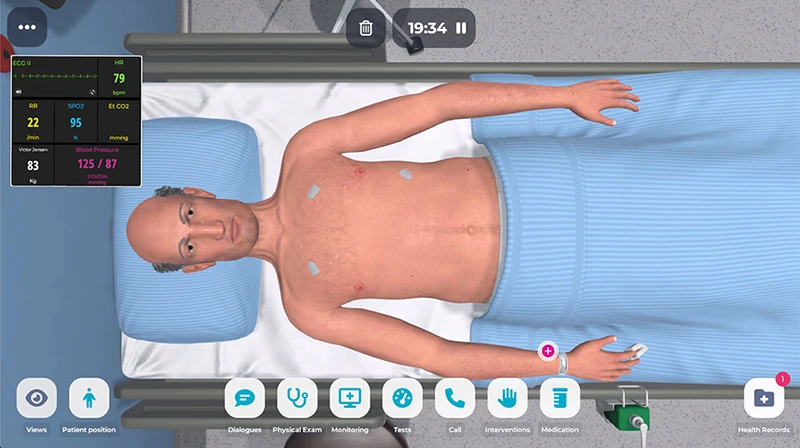Welcome to the Body Interact simulation environment! This page provides a quick guide to the main features and controls within the simulation interface. The numbered sections in the screenshot below correspond to key controls and tools you’ll use during your scenarios.
Simulation Interface Overview

1
Next Step Menu
2
Vital Signs Monitor
3
Views
4
Patient Position
5
Dialogues
6
Physical Exam
7
Monitoring
8
Test
9
Call
10
Interventions
11
Medication
12
Health Records
13
Play/Pause
14
Timer
15
Bin
- Next Step Menu
Click here to exit the simulation or access the Help Center. - Vital Signs Monitor
Monitor Vital Signs like Blood Pressure, O2 Saturation, Heart Rate, and Respiratory Rate. - Views
Adjust your perspective to get a closer look at different parts of the patient’s body. - Patient Position
Change the patient’s position, such as having them sit up or raising the bed. - Dialogues
Talk to your patient to gather information or provide instructions. - Physical Exam
Conduct a thorough physical examination of your patients. - Monitoring
Activate the vital signs monitor and check additional parameters like Temperature, Blood Glucose, and Urinary Output. - Test
Select and order complementary medical exams and laboratory tests. - Call
Determine if any medical specialties should be contacted for consultation. - Interventions
Access a wide spectrum of interventions that can be performed on the patient. - Medication
Choose the appropriate medications to administer. - Health Records
Access the patient’s Health Records by tapping the folder icon or by pausing the simulation. You can also review your Performance Status and the scenario’s briefing. - Play/Pause
Pause and resume the simulation. - Timer
Keep track of the time remaining in your simulation. - Bin
Click the Bin icon to close all currently displayed tests and exams.
Each of these controls is vital for an interactive, educational, and realistic experience with Body Interact. The simulation replicates real-world clinical environments, and understanding these controls will help you make informed decisions and optimize patient care.
Was this article helpful?
YesNo




